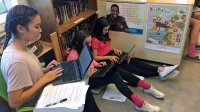Flexible Seating in Middle School
Tips on giving your students a choice about where and on what to sit—including ideas about seating charts and classroom management.
Your content has been saved!
Go to My Saved Content.I was already experimenting with flexible seating in my eighth-grade English classroom when I saw a video about combating writer’s block by working in a box castle.
We don’t have room for cardboard castles, but I could string up “box castle lights” and let students rearrange the furniture into writing forts. My students loved it! They turned tables upside down, built forts with their chairs, grabbed carpet squares to sit on, and settled in to write for a solid hour. They happily cleaned it up at the end of class and repeated the process every extended writing time. The next year my district made a commitment to flexible seating by equipping every classroom with seating options and chairs on wheels.
Flexible seating can add a wrinkle to classroom management, but with careful planning and clear expectations, our students will rise to the occasion and use flexible seating to improve their own learning environment. Here are the ways I’ve addressed classroom management in a flexible classroom.
Seating Chart
My students start each class period in assigned seats arranged in rows facing the front so that I can take attendance, go over the agenda, announce the homework, and take care of any direct instruction. With classes of students coming and going all day, the seating chart provides a smooth start for each group. Even if you teach in a self-contained classroom and can easily take roll no matter where your students are seated, I encourage you to have seating charts so that when you’re not there, your students will be familiar with the seating expectation and your substitute will know who’s who.
Assigned seats also address what is often an invisible issue for many students: the social anxiety that comes with entering a room and not knowing where to sit. Where are my friends? Who will let me sit next to them? Where is that kid who keeps teasing me?
Flexible Seating Options
After our start-of-class routine, students may move their desks (or move to a different kind of workspace) in order to work where they are most comfortable and productive. Often they have the option of working with other students. This flexibility includes being able to move again if their current location isn’t working for them.
Flexible seating options include:
- Working at tables or traditional chairs with attached desktops
- Standing at bookshelves or tall tables
- Sitting on gaming rockers or stools, or on carpet squares on the floor or outside on the ground (weather permitting)
- Sitting or kneeling on pillows at low tables
- Sitting on soft seating, beanbag chairs, or couches—some fire codes allow only fire-resistant fabric seating, so check with your administrator
- Sitting on the floor in work nooks—corners created with bookshelves and walls
You may allow students to use headphones to listen to music while they work (to block out distractions).
Expectations and Class Norms
If we want our students to succeed in a flexible environment, we need to be clear about our expectations. Can they really sit anywhere they want? Does that include on top of tables? Under tables? And what about behavior? Do our expectations change with seating options? I start the school year with lessons and activities to introduce my students to my expectations, including around seating options. My students need to know that after we start each class in assigned seats:
- With teacher direction, they may move to specified options.
- With teacher direction, they may work with/talk to others as they work.
- During work time, they may move to better environments for them.
- If they are disruptive or not working, they may be moved to a new location.
There are times when we have to go back and revisit the expectations and sometimes make modifications. For instance, I noticed that students would roll their desks back against a wall where I couldn’t see their screens. I didn’t want to assume they were off-task, but I also couldn’t help them with their work if I couldn’t see their screens. So we added the rule that if they were working on devices, they needed to be seated in a way that I could see their screens.
A fun way to train students to move seats into various configurations is with Desk Olympics. Furniture on wheels makes it easier to move from rows to partners to groups to a whole-class discussion circle, but those transitions can be noisy and time-consuming. We practice moving into the different formations, racing against the clock to see how fast we can finish. Extra points for silence!
Classroom Management
What about classroom management in a flexible seating classroom? Do some students abuse the freedom? Of course. Do some students lose some of their seating privileges? Yes, temporarily. But after three years of teaching all levels of middle school students in a flexible environment, I can say that the benefits far outweigh any management issues that arise. Students respond positively to the freedom and responsibility they are given, and they work hard to keep those privileges. But of course we teachers need to plan carefully, communicate clearly, and be fair and consistent in enforcing the expectations. Plan your transition to flexible seating with:
- A start-of-class seating chart and routine
- Clear expectations for behavior
- Guidelines for where/how students may work
- Consequences for abuse of the seating options
More Resources
For more information about flexible environments, check out John Thomas’s post on flexible seating for first and second graders, and see these resources that he and I put together:
